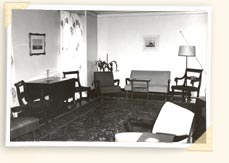
Filling staff shortages
On Christmas Day 1910, the Hospital’s only two doctors
were taken ill. The medical superintendent was left alone
to treat the Hospital population of 750 until two McGill
medical students sacrificed their holidays to assist him.
Frustrated at the chronic understaffing, he complained, “To
expect two men, the number allowed by the Government to look
after a population of 750, is absurd.”
Fortunately, that same year, other healthcare professionals
in the community offered to help improve the physical health
of the patients. The Hospital’s publicly-funded patients
were being treated free of charge by a long list of professional
consultants, including: a surgeon, two physicians, a gynecologist,
two pathologists, a neurologist, an optometrist, an ear specialist,
an orthopedist, and a surgeon dentist.
By 1913, no pension benefits were available to doctors,
including the medical superintendent, “To no body of
scientific men, not too lavishly paid, although rendering
invaluable service, is such a procedure more justly due…for
their declining years.”
Improvements in quality of life
Though Thomas W. Burgess, MD, noted
difficult conditions in 1896 for some employees living on
the Hospital grounds, distinct improvements were achieved
in later years.
1896, Thomas Burgess, MD: “The lack of cottages in
the vicinity of the Hospital is a great hardship to our married
help and it is hoped that some means may be adopted to supply
this want.”
1896, Thomas Burgess, MD: “A separate building for
the use of nurses…is needed. Attendant’s hours
on duty are long, thirteen to fifteen hours daily, and their
work is extremely exhausting. Sleeping on the wards [disturbs
their rest], and they are forced to begin their morning duties
already tired-out and irritable; a state of affairs bad for
both their patients and themselves.
The work of an attendant in the care of the insane is arduous
in the extreme. Many good and efficient employees resign
and leave because they find the absolute need of relief and
quiet from the harassing incidents of asylum life. It is
the policy of all advanced modern hospitals for the insane
to isolate the nurses, when off duty, from the scene of their
daily labours, and to make their living apartments as attractive
as possible.
It is assumed that the increased comfort of such an arrangement
and the separation from the constant wearing worry of continuous
encounters with the inmates will retain them longer in the
service, as well as keep them in better health and spirits.”
In 1916, Staff House (Dobell Pavilion) was built to give
the nursing staff separate living quarters and relief from
the demanding work environment.
In the 1950s, most of the senior hospital staff still lived
on the hospital grounds. Besides saving time in commuting
to and from work, this added a safety factor in case of fire.
An electric fire alarm system was installed, with terminals
in many staff homes on the grounds. Whenever it rang, the
staff quickly made their way to the Perry Pavilion switchboard
and operations were directed by the most senior person present. |